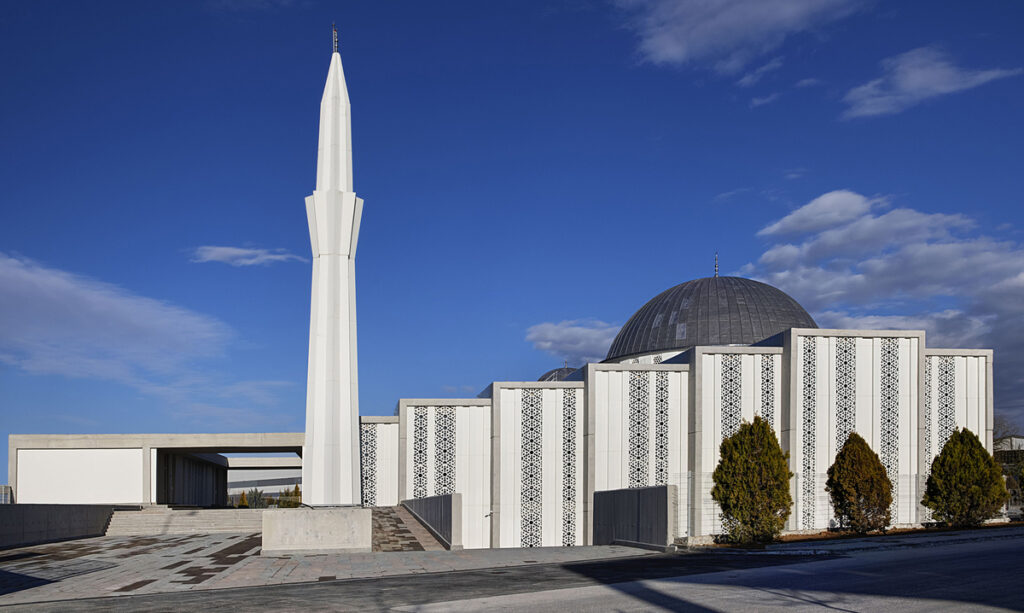Turkey’s rich history and wide range of cultural influences are reflected in its architectural legacy, which is an intriguing trip through time. Turkey’s architectural styles have changed and evolved over the years, from the breathtaking monuments of the Ottoman Empire to the contemporary marvels of today.
Regional architectural differences in Turkey are partly a result of the country’s large and varied geography. A distinctive fusion of architecture and environment may be seen in the traditional stone buildings of Cappadocia, which are carved into the fairy chimneys. Notable instances of regional architectural attractiveness are the stilt buildings of the Black Sea region and the timber cottages of Safranbolu.
Construction project in Turkey continues to reflect Turkey’s long history as a melting pot of diverse cultural influences. The Turkish land can portray this blending of cultures in a setting that is more vivid and majestic than would otherwise be possible because of its conspicuous center position between Asia and Europe. Due to its turbulent past and diverse population, the city has developed a wide range of architectural styles throughout its existence, including those practiced by Ottoman architects, each distinguished by a distinct set of characteristics.
The features of Turkish architecture that I will go over below are specific to Turks and have been inherited over the years. Examples of this architectural style can be found in Istanbul houses and throughout Turkey’s real estate market.
Table of Contents
An Overview of Turkish Architecture
Turkey has long been a melting pot of cultures, particularly when it comes to architecture. Because of its strategic location halfway between Asia and Europe, the Turkish region can showcase this cultural diversity in a more vivid and opulent manner. Due to its vibrant past and multicultural population, a multitude of various design styles have emerged over time, each with unique qualities.
Early Turkey
Turkey saw the start of a unique architectural movement following the establishment of the Seljuk Empire. Despite having a diverse population, the empire did a great job of adapting its architectural styles to the Turkish environment. Numerous tombs, mosques, medreses, hospitals, palaces, baths, etc. were built during this time. Construction project in Turkey was distinguished by their graceful, unadorned formwork with straightforward proportions. These buildings were somewhat simple, but they employed the idea of a “Monumental Portal,” an entryway with ornate, colorful decorations.
Seljuk architecture, which is sometimes referred to as “Poetry in Stone,” was distinguished by the use of enormous blocks of exquisitely prepared stone and brick, as well as relief work that displayed the dynamic play of light and shadow. Construction project in Turkey typically had domes, muqarnas, minarets, and “Turkish triangles,” which are triangular pendentives that support the dome. Eyvans are three-sided walled rooms with the fourth side open to a spacious interior courtyard.
A great illustration of the style is the Çifte Minarelli Medrese located in the region of Erzurum. Its expressiveness depends entirely on material and formwork that are in proportion. Other important elements included the internal courtyard, the usage of muqarnas, and the ornate brick and tile masonry.
The Ottoman Empire
Following the Ottoman Empire’s growth, intricate and graceful building designs—typical of Construction project in Turkey—were created during this time. The Middle East, the Mediterranean region, and Byzantine influences were all combined to create the Ottoman style of architecture. The primary architectural typology of the style included mosques, as well as complex structures, the kuliye (baths, hospitals, schools, etc.), palaces, tombs, fountains, etc. Grand, rhythmic formwork with an emphasis on hierarchy and harmony was a feature of the designs.
During that time, domes, minarets, buttresses, and other architectural elements were typical. With variations in the arrangement, size, and several of these building parts as well as the ornamentation and decorating shown in the interiors, most designs adhered to the same study of proportion, basic layout, and material, always evoking a sense of splendor and majesty.
Sedefkar Mehmed Agha created the Blue Mosque, dubbed the “Apple of Istanbul” and the final undertaking of the ancient Ottoman Empire. Even though the exteriors exude luxury, the interior décor, natural light, and the use of symmetry and repetition all combine to create a heavenly atmosphere that is ideal for prayer and the study of religion.
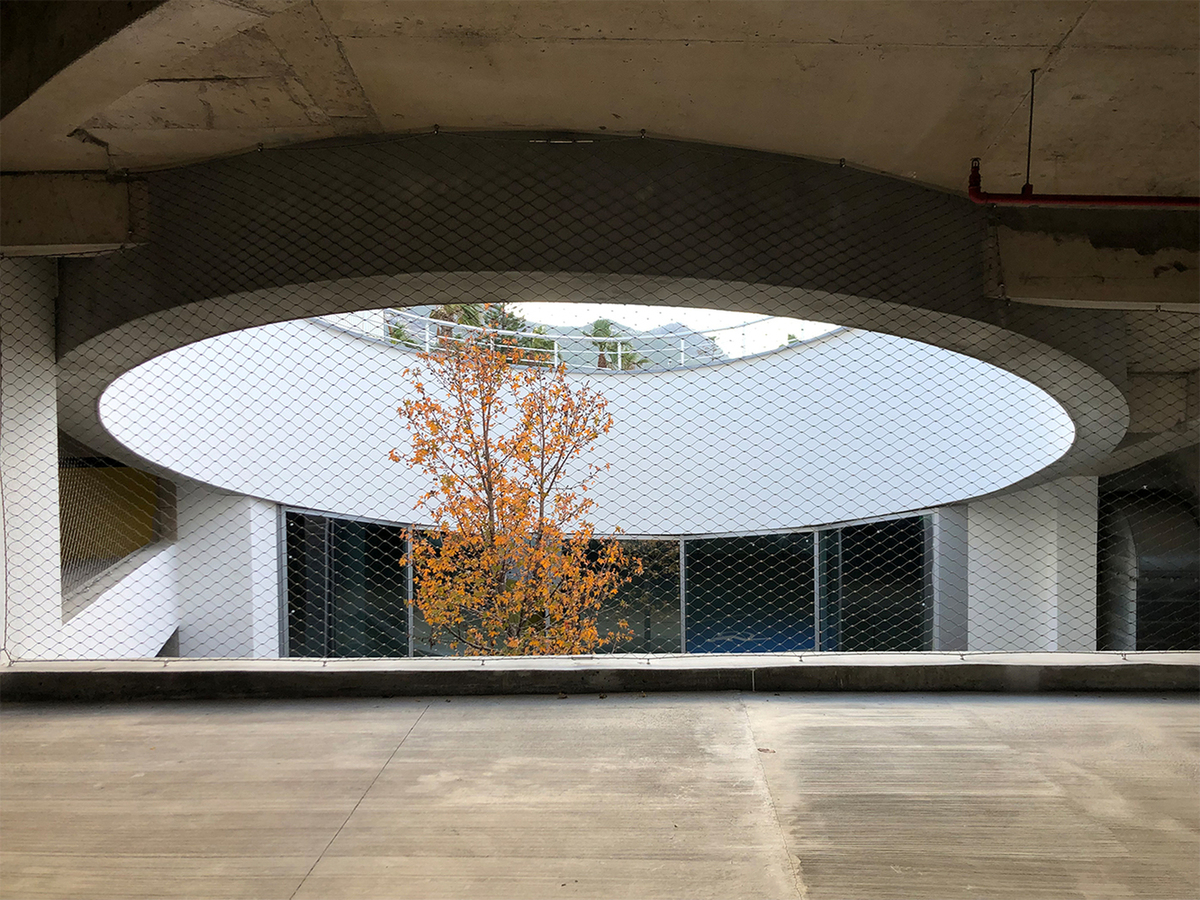
European Fascination
The Turkish region witnessed a rise in attraction to Western ideals, both in terms of designs and lifestyles, as the dynamics of dominating powers in the region evolved. The Baroque and Rococo styles, among other European influences, were incorporated into Ottoman designs, leading to a range of hybrid Turkish architectural styles, including the Empire, Baroque, and Tulip styles. As a result, the kind of structures that were created changed, and traditional formwork began to include features of European architecture.
The Fountain of Ahmed III, an example of the Tulip style, the Nuruosmaniye Mosque, an example of the Baroque style, and the Ortaköy Mosque, an example of the Empire style all presented diverse styles that reflected dignity and elegance.
Nationalist Movements
The First National Architectural Movement, which was started to instill a sense of nationalism and pride in the Turkish territory, rose to prominence in the area between 1890 and 1930. To create a new architectural style for the area, they turned to earlier, regional ideas and styles. This movement’s designs included several Seljuk and Ottoman architectural components and stylistic aspects.
The government hired roughly 40 foreign architects and urban planners to assist with this issue as building requirements increased until the 1950s and there weren’t enough Turkish architects available to design these projects. They also assisted in supervising the construction of Ankara, the new capital. Popular architectural styles such as the Bauhaus and Art Deco were introduced to the nation by these architects, as demonstrated by the designs of Şekip Akalın’s Ankara railway station and Seyfi Arkan’s Florya Atatürk Marine Mansion.
The government hired roughly 40 foreign architects and urban planners to assist with this issue as building requirements increased until the 1950s and there weren’t enough Turkish architects available to design these projects. They also assisted in supervising the construction of Ankara, the new capital. Popular architectural styles such as the Bauhaus and Art Deco were introduced to the nation by these architects, as demonstrated by the designs of Şekip Akalın’s Ankara railway station and Seyfi Arkan’s Florya Atatürk Marine Mansion.
As the modern architecture movement gained global recognition, the Turkish region witnessed the emergence of a second national architectural movement, spurred on by the entry of foreign architects and inspired by European fascist architecture movements in Germany and Italy. This movement focused on the architecture of government buildings, emphasizing their sense of authority and power through the use of enormous proportions (big walls and windows). Structures from the trend, such as the Anıtkabir mausoleum, evoked memories of the Neo-classical movement with its symmetry, simplicity, and total lack of adornment.
Modern Architecture
Following a time of significant social upheaval brought on by several political movements and economic crises, the Turkish architectural landscape was obliged to adapt to survive. The rationalistic design approach was dropped in favor of a more disjointed, adaptable, and contemporary formwork.
Furthermore, Turkey was observed to be extending its influence in international trade agreements, which had a significant impact on the building sector and, consequently, Turkish architecture. With today’s technologies and technology, architects could now add color to the rapidly expanding Turkish society. Formwork underwent a significant change as a result of the introduction of new materials (steel, aluminum, plastic, etc.) and technological advancements (prefabrication technology and curtain wall systems), which had a significant impact on the local architecture scene.
Top 7 Construction Project in Turkey
Let’s explore the list of the top 7 construction project in Turkey worth knowing about:
1. ZENEL Residential Building
Area: 3987 m²
Year: 2017
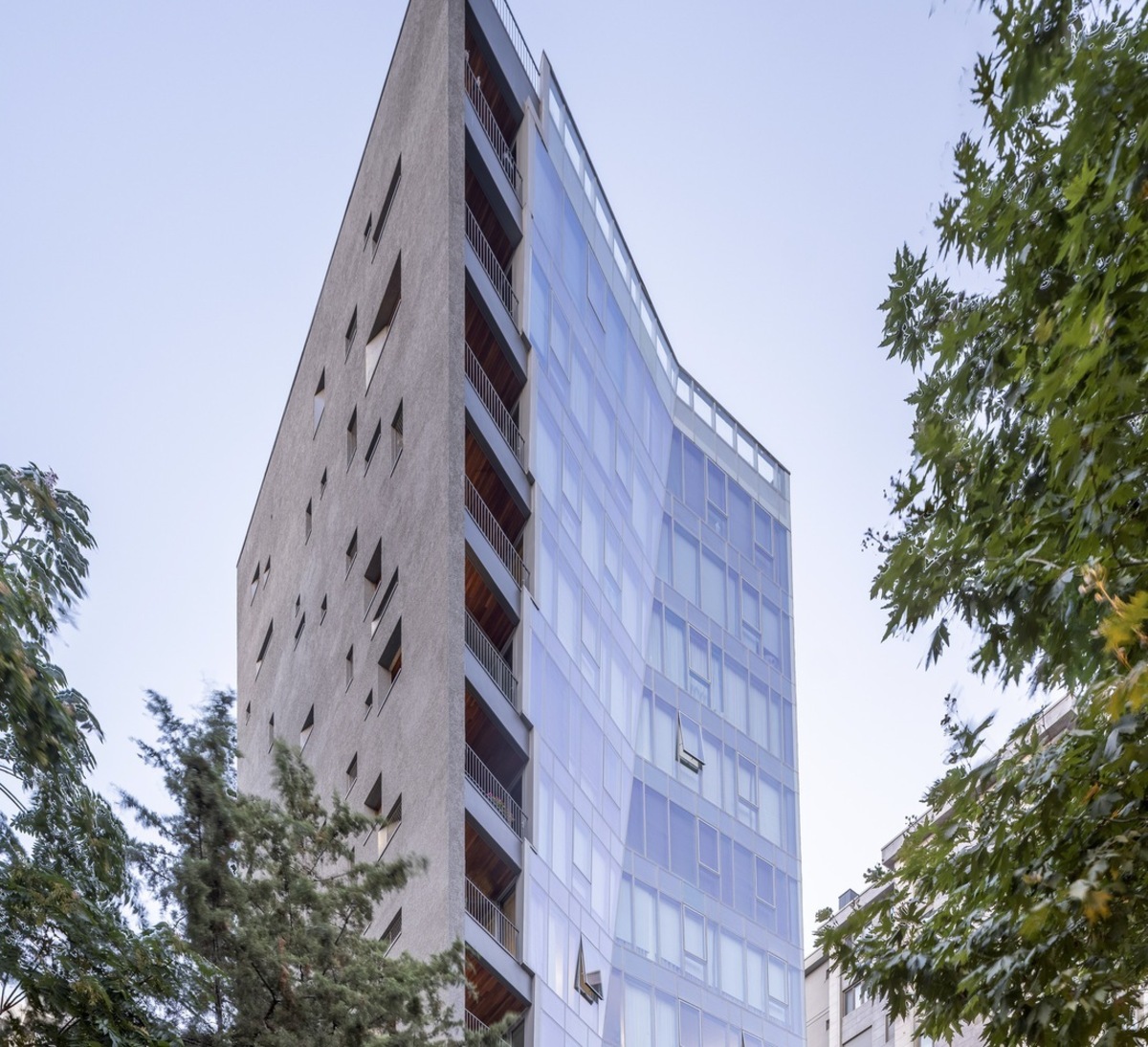
The 14-story residential building Zenel is located in the affluent residential neighborhood of Erenköy, on the Asian side of Istanbul, close to the bustling Bağdat Avenue, which stretches approximately 14 km from east to west, nearly parallel to the coastline of the Sea of Marmara. In contrast to old Istanbul, this relatively new neighborhood features a grid pattern formed by the east-west axis of Bağdat Avenue.
The building’s sky plane is rotated to face the Prince Islands, an archipelago located 10 km south of the Marmara Sea coast, while the site’s ground plane follows the “Bağdat Grid” to run parallel to the avenue. The Bağdat Grid and the view of the Prince Islands exert a tension on the building from top to bottom that gives the impression of molten rock crystallized.
Buildings often have a tripartite structure that is connected to classical columns. The shaft, the top, and the base. Here, the virtual base and virtual capital are concealed by the reflected pool and the sky. The torque force-induced top-to-bottom transition is amplified in this intermediate state. The severed shaft has the appearance of a rock with a polished, glistening interior and a rough, worn exterior. This produces a temporal dualism where the old and the new are in opposition to one another.
2. KOS Mosque
Area: 4000 m²
Year: 2020
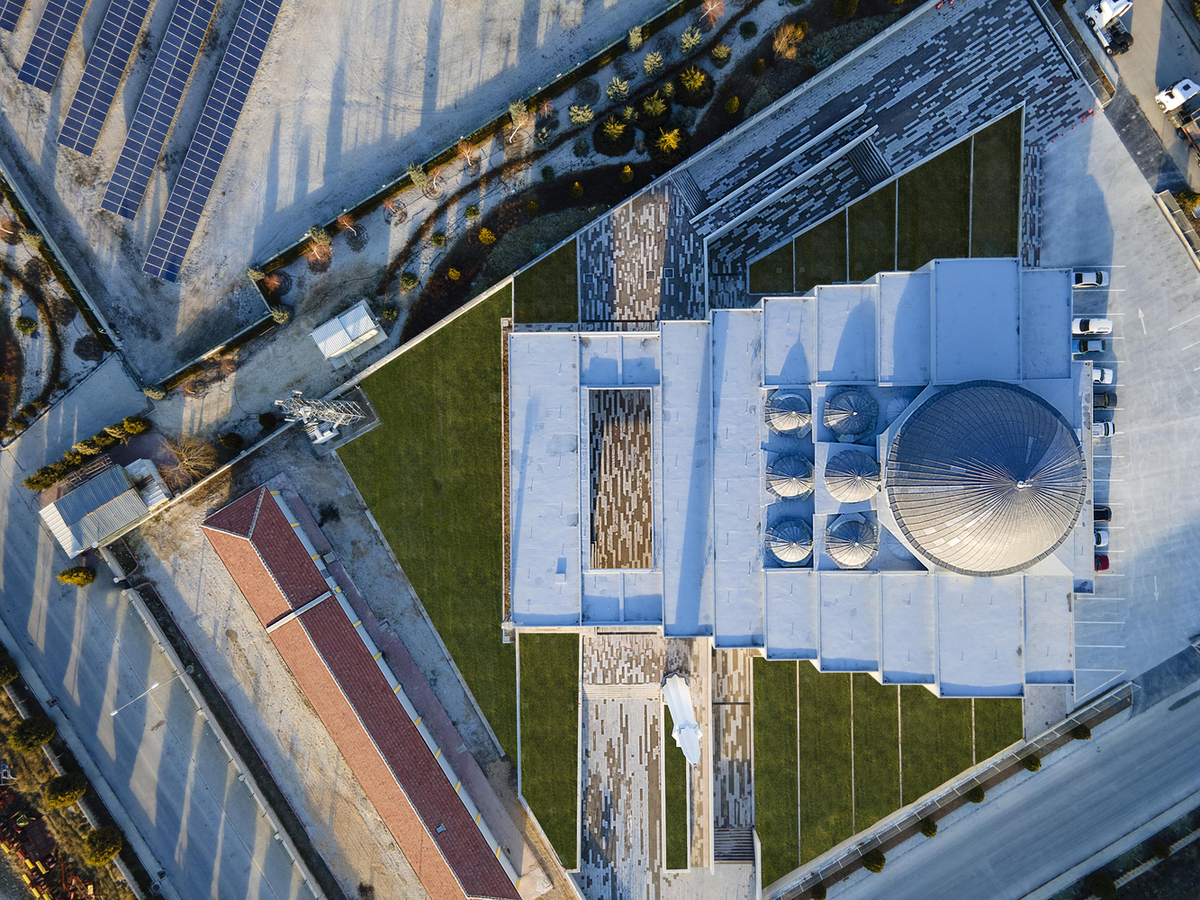
The Konya Organized Industrial Zone’s KOS Mosque is a refurbishment project of one of the conventional mosque projects; it is regarded as both an intervention in a location with structural and fictional inadequacies and a place of worship. This construction project in Turkey is a fresh take on the idea of redesigning the approximately 85,000 mosques that are now in Turkey and growing every day rather than tearing them down and starting over. The primary objective of the design process has always been to achieve harmony between the existing building and extra volumes, using data from existing buildings as a guide.
The KOS Mosque is situated in the industrial zone at the crossroads of two busy roads. The sole building entrance in the existing structure was elevated from the ground, and users were directed to it via a garden entrance. The primary focus of the design process has been to analyze the increased circulation that would result from the nearly doubling of the number of users and to make sure that there is continuity between the entries and exits.
The current street entry was kept and made larger by these guidelines, and an additional entrance from the adjacent street was added. The new mosque’s courtyard, which serves as both the main entry and the hub of the ablution area, is where these entrances converge.
As a result of the growing capacity, four distinct entrances have been planned to serve as the ground and basement floor axes’ centers. Five exposed concrete blocks, the longest of which measured twelve meters, were added to both sides of the mosque, creating the main prayer hall, following the trace of the carrier system of the current mosque. The mihrab, entrance, shoe shelf, courtyard, and ablution area are added to these masses to form the new mosque mass, which has a total of 11 primary axes. To the southwest, a 2-meter curtain wall was erected to highlight the mihrab region on both floors.
3. Turgutreis Community Center
Area: 8000 m²
Year: 2023
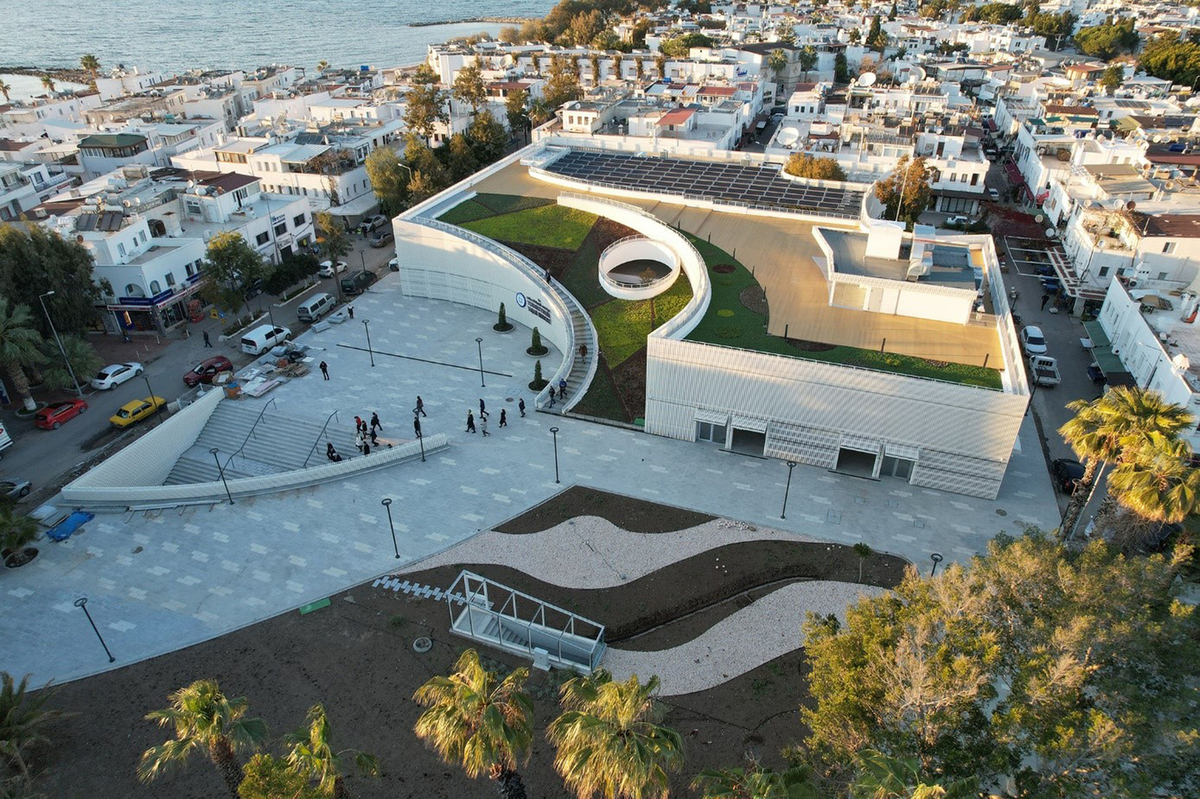
The Turgutreis Community Center is a public project that aims to restore the memories of a seaside town that has lost its sophisticated fishing town charm from the 1970s due to retiree migration, tourism, and the change of annuity housing. It also seeks to find answers to the ever-changing needs of the city.
Although the original design brief was for only a standard multi-story parking structure to boost the town’s parking capacity, the building design program has since been reevaluated in collaboration with the local government with an eye toward more effective architectural expression.
Rejuvenating the surrounding park scenery while also concealing a multi-story parking structure within the building core, this construction project in Turkey has 8.000m² of enclosed space, craftsman ateliers, and market halls that allow both locals and visitors to sample the cuisine.
4. AGU Presidential Museum and Library
Area: 5423 m²
Year: 2016
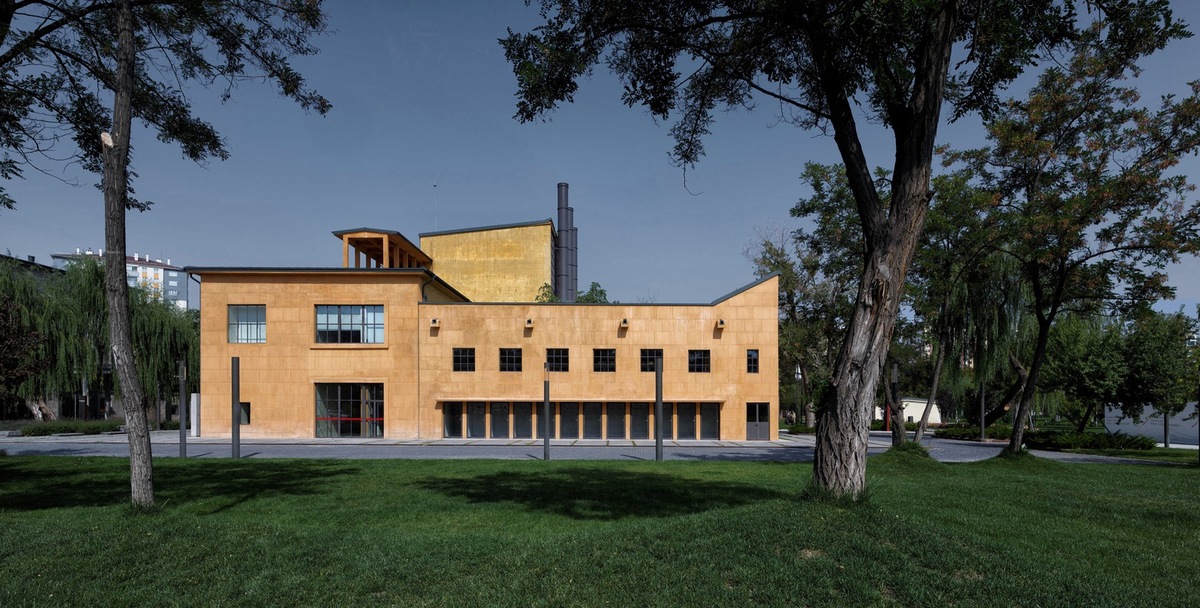
The Sumerbank Textile Factory in Kayseri, Turkey was made up of numerous sections, two of which are the refurbished Presidential Museum and Library buildings. Constructed between 1933 and 1935, this production complex was the brainchild of Russian architect Ivan Nikolaev and stands as one of the most notable examples of modernization and industry in Turkey during the Republican era.
Following its closure in 1999, the industrial complex—which houses exceptional examples of Russian Constructivist architecture—was designated as a contemporary monument and became the primary campus area of AGU, a recently founded university, in 2012.
All of the structures, which had been neglected and decaying for years, were large and still retained some of their original patina. Preserving the original features and conserving whatever material has endured throughout time was the basic strategy. The goal of the architectural strategy of fusing old and new was to produce a cohesive architectural whole rather than to highlight the differences between pieces that belonged to various eras.
In this regard, a lot of work went into preserving the components that already existed and figuring out how to manage the building services in a way that complied with all the safety and accessibility regulations. The selection of the materials reflects the idea of maintaining the buildings as much as possible. The Power Plant’s interior was planned to give visitors a sense of the building’s history while also making the most of the facility’s newfound role as a museum. The original ash pits were concealed beneath multiple layers of covering, but they were kept visible to form an important component of the display.
After renovation, the Steam Plant is now a state-of-the-art information hub with library and archive areas that are closely connected to the museum. A more audacious addition to the Steam Plant’s main hall is a three-story bookshelf structure that blends in nicely with the existing architecture both spatially and formally. Like the ash chambers in the power station, the original concrete silo bases have been retained and are now comfortable reading rooms that draw attention to the space’s volume.
5. Pako Street Animal Social Life Campus
Area: 29916 m²
Year: 2022
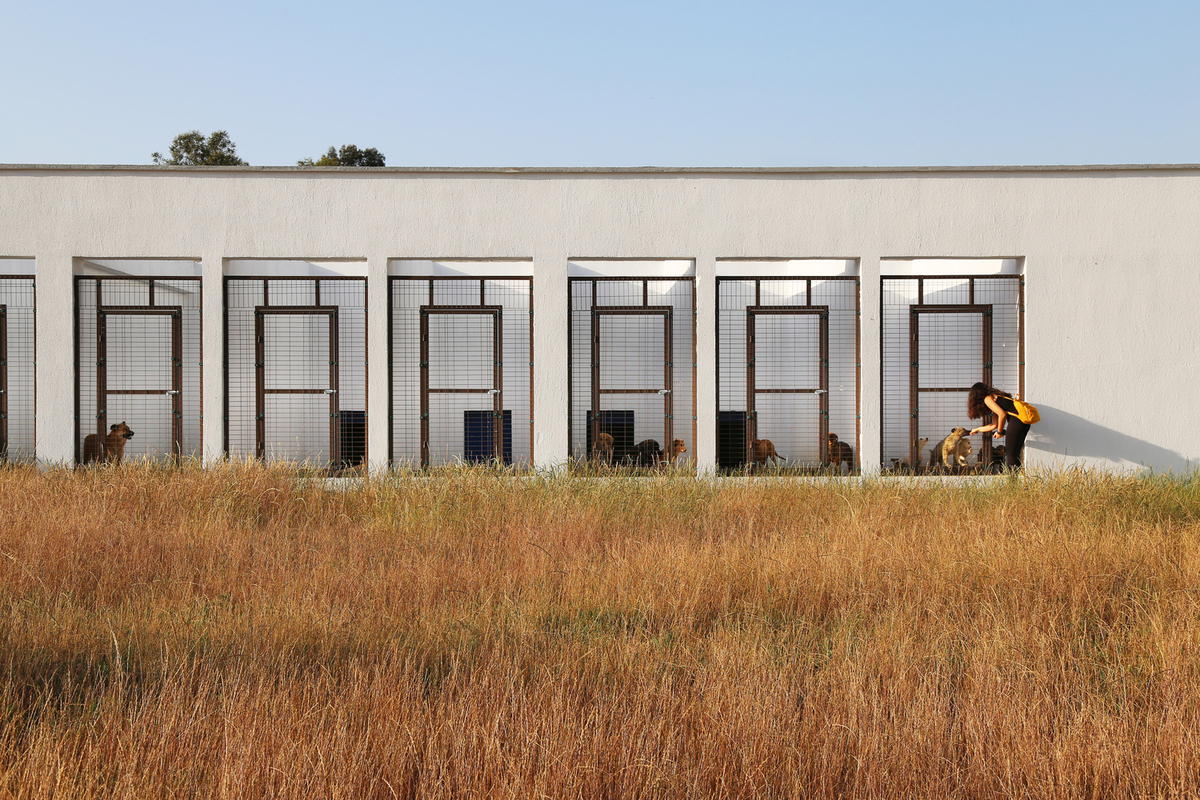
The primary goal of stray animal practices in Turkey is to provide much-needed care to animals that have been abandoned, injured, sick, disabled, or destitute to return them to their natural environments once their treatment is complete. This construction project in Turkey, which occupies a 110.000 m2 plot of land in the Gökdere district of the town of Bornova in Izmir, is designed with open and closed spaces that emphasize human-dog interaction while also reinforcing the theme of adoption.
This unique facility was intended to serve as both a short-term care facility and a rehabilitation center based on human-dog interaction. It offers a space that supports the concept of reciprocal rehabilitation and serves as a substitute for families looking to spend quality time together while reinforcing human-dog interaction.
The middle area of the property, which houses an open amphitheater, administrative offices, and shelters for pups and purebred dogs, divides the shelters, which are arranged along its north and south borders. At the east end of the property are units housing violent dogs, a quarantine unit, and veterinary services units.
These shelter units, which serve as the project’s main building blocks, are made to address the issues of cleanliness, security, accessibility, and a dearth of green space that many shelters encounter. They also feature open, cozy areas with soft scapes—a combination of dirt and green spaces—that further integrate the project with the surrounding environment.
The decision to incorporate naturally occurring light and air ventilation, an automated watering system, soft scapes inside the enclosed areas, and translucent green and blue features led to the development of the shelter units’ design and spatial layouts. Additionally, the visual links between the dogs and visitors are made possible by the wire mesh screens that border the inner circulation axis façades.
6. Golden Horn Waterfront Sports Park and Public Space
Area: 30000 m²
Year: 2023
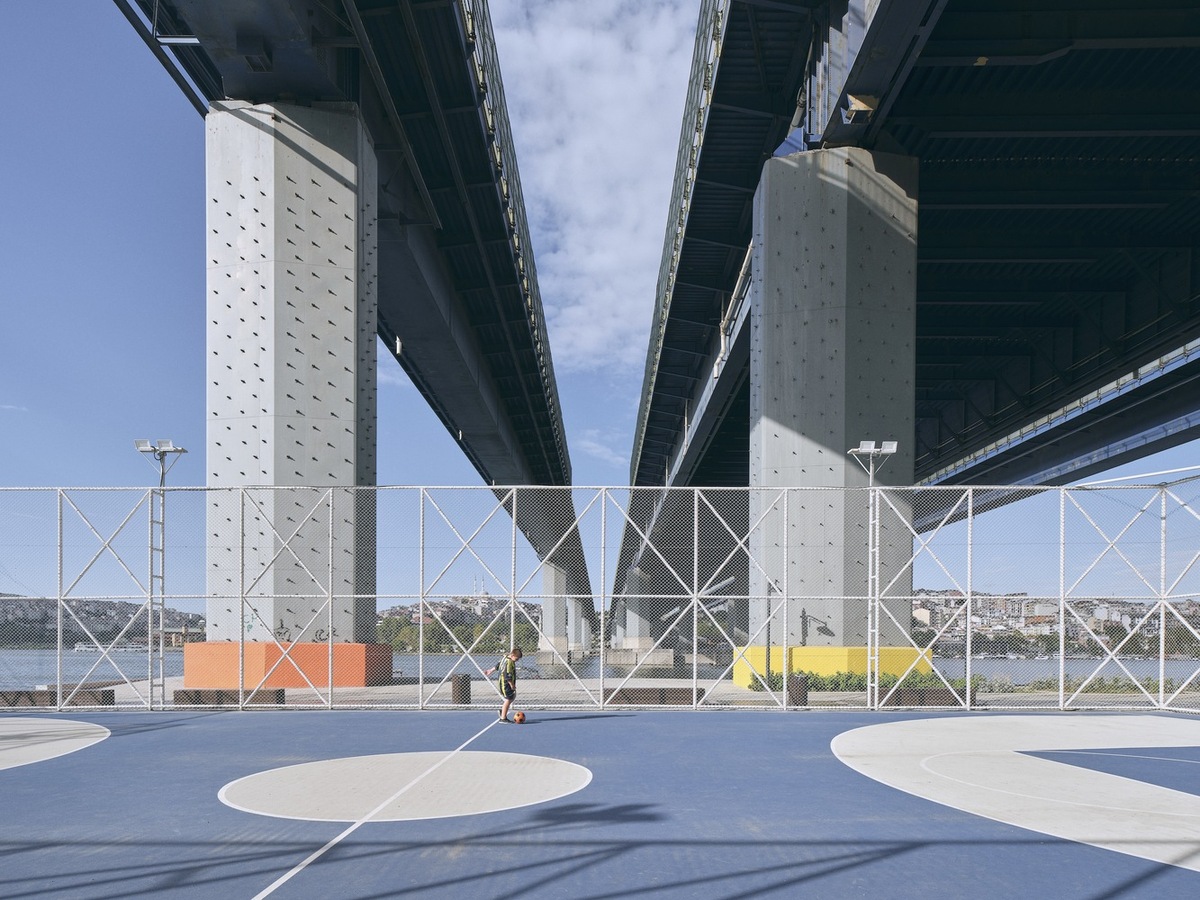
The Balat-Eyupsultan Coastline construction project in Turkey, which took first place in the “Istanbul Golden Horn Coasts Urban Design Competition,” encompasses 230.000 square meters in total. The Golden Horn is the main inlet of the Bosphorus, forming a port in the shape of a horn and defining the northern edge of the peninsula that makes up “Old Istanbul.” “Waterfront Sports Park and Public Space,” one of the most significant project areas, has been built and is now accessible to the general public.
The Location: The Golden Horn Region, home to a naturally occurring harbor, has been Istanbul’s principal port since the Middle Byzantine Period. The Golden Horn’s coasts, which were known for their recreational and leisure spaces before the Industrial Revolution, took part in its production process at that time. Around this time, the neighborhood began to take on the characteristics of an industrial area, home to establishments like Feshane and Sutluce Slaughterhouse.
The area lost its industrial identity and its connection to the Golden Horn shoreline to urban life when the scope of various urban projects was altered after the 1980s. Filling areas were added, new highways were built parallel to the coast, and demolitions were carried out disregarding the area’s historical significance.
The redevelopment of the Golden Horn shoreline has also been aided by the public transportation expansion that encompasses the entire city of Istanbul and began in 2016. Without higher-level urban planning decisions, the Golden Horn Tram line was built, further harming the already strained interaction between the shore and cities and isolating coastal life. In this context, the “Istanbul Golden Horn Coasts Urban Design Competition” was launched in 2020 to regulate these relationships that were damaged during the historical process and enhance the Golden Horn’s urban use (Competition Specifications, 2020).
7. Kinik Olive Agricultural Production, Processing & Storage
Area: 450 m²
Year: 2023
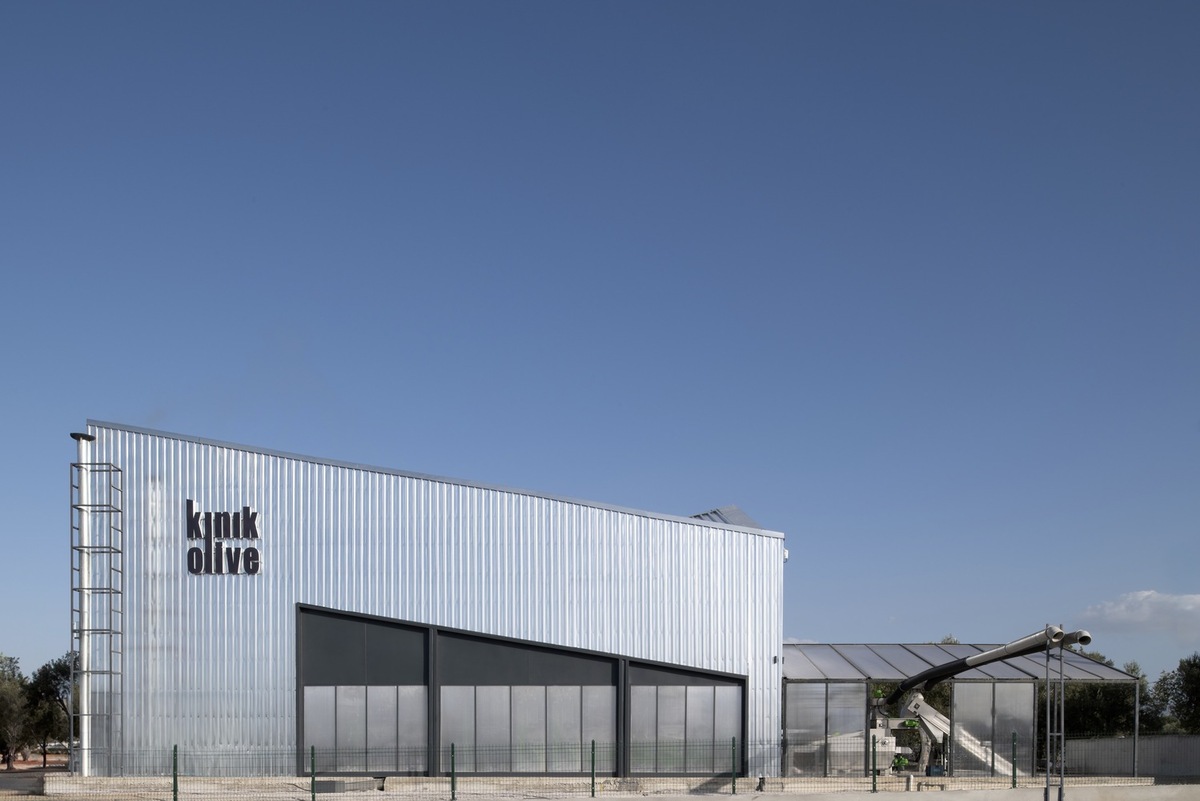
Launched in November 2023, Kinik Olive is a small-scale industrial facility with a daily processing capacity of 80 tons of olives and a production capacity of 20 tons of olive oil. It was designed by Studio Evren Başbuğ for an agricultural development cooperative in Kinik, a northern district on the outskirts of İzmir.
This construction project in Turkey was constructed with a steel structural system on an elevated platform, and it was intended as a single-volume space, putting aside the technical and wet volumes in the building program brief. The building is anticipated to set itself out from comparable establishments in its environs with its reverse-sloping roof form and the sharp angles of this form mirrored in the façade arrangement. It is situated among existing olive trees in a rural area.
In addition to reflecting sunlight that strikes at different times of the day and from varied angles, the galvanized trapezoidal coating panels on the façade and roof surfaces also capture the colors of the sky and the surrounding densely vegetated olive tree landscape. The construction is meant to blend in with the rural landscape, seeming transparent in terms of color and texture and occasionally practically dissolving into it, despite its form, which at first glance seems foreign and incompatible with its surroundings.
In conjunction with the milk processing facility, which was also a recent investment made by the cooperative in the district, the Kınık Olive facility seeks to support the local circular economy by enabling local producers to process their products and create value-added products for the end user under more hospitable conditions.
Conclusion
Talented Turkish architects have been creating waves in the world of architecture in the twenty-first century. International recognition has been awarded to architects for their creative designs and environmentally conscious methods. Through the seamless fusion of modernity and Turkish heritage, their works redefine the nation’s architectural landscape.
Modern construction project in Turkey have reached several benchmarks. In addition to making several advancements in typology, expression, and overall design, the nation has established itself as a leading location for modern, historical, and contemporary architecture. To adapt to the changing times, many Turkish architects incorporate contemporary building materials and methods while preserving the opulence and rich cultural heritage of ancient Turkey.
Furthermore, a lot of thought is given to preserving sustainability in the design to raise the energy efficiency of these local structures. Even in the modern era, Turkey is a country rich in history and culture, vitality, and natural beauty.
Turkey’s rich cultural legacy and deep historical heritage are reflected in the variety of architectural styles found there, spanning from the Ottoman era to the present. Turkey’s distinctive architectural legacy is influenced by the elaborate designs of mosques and palaces, the fusion of traditional and modern elements, and regional differences. Turkey’s architectural journey is continuing to change, with a new generation of innovative architects and a dedication to preservation making a lasting impression on the global scene.
Suggested article for reading:
Top 7 Construction Project in Italy
Top 7 Construction Project in Luxembourg
Top 13 Construction Project in Denmark
Resources:
Wikiwand | Vartur | RTF | AllAboutTurkey | ArchiVibe | RoyalWhiteProperty | Archdaily
For all the pictures: Archdaily

